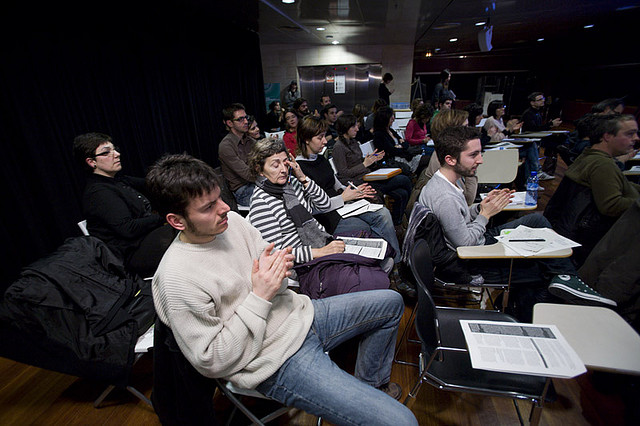
I+C+i Multiplatforms session. CCCB. 16 march 2010.
The discussion of I + C + i session on multiplatforms could be followed face to face, but was also broadcast live via video streaming and Twitter. We now have to consider the virtual public, whose importance grows each day and is beginning to be as important as traditional public, if not more. This is a little consideration on how we can analyze these new audiences based on experience of the last I + C + i session.
The web provides a highly reliable and objective data on public. According to Ustream metrics (the service that performed the streaming broadcast) the debate was seen live by 99 people. These users viewed a total of 79 hours of video. We also know that the average number of users online was 31. But with this data we can not know how many people followed the whole debate and what number of users followed only a few minutes. And although Internet offers a lot of information, it is impossible or extremely difficult to get a certain type of very specific information. In this case and with the data we could extract, a minority of between 20 and 25 people followed most part of the debate (and therefore consumed most of the 79 hours of video) while the rest of the users followed it for a short time.
In the case of Twitter, the duality between the data we have and the one we cannot access yet is more evident. Part of the data we can access is how many people have participated with a comment. 163 messages were posted with the hashtag #multiplataformas. But it is impossible to know how many messages related to the conference were published without the label. At the same time, we cannot know how many people actually read these messages, or to whom these messages finally arrived by retweets. And this brings us to consider another feature of the new audiences: the inability to control the expansion of our information through the network, and therefore understand its full impact.
Perhaps it is in blog format where we have more control over the public. According to Google Analytics, 270 users visited the blog at I + C + i on the day of the Multiplatforms session, while the average daily access to this website during 2009 was 28. Therefore, despite not being its main objective, the blog highlights the importance of social networks in the dissemination of content. About 15% of users that accessed the blog I + C + i on this day did it from Twitter and another 15% did it from Facebook. We can not get data from the public once our information gets out of the channels of control, but we can get an overview of how this expansion causes a re-entry to users of our channels.
Ultimately, this data allows us to discover new behaviors of new audiences. Internet favors delocalization and atemporality. It is clear that many of the people who followed the debate on streaming or Twitter were not able to be at CCCB on the 16th to follow it live. Still, only 25% of users that entered the blog on the 16th were outside Barcelona. Therefore, even if sessions can be followed from anywhere in the world, the local factor is still very important. The fact that content can also be found at any time affects the fact that more people can see it. Some of the videos that I + C + i have posted on Blip.tv have been played over 300 times, surpassing the number of people that can physically attend the sessions. In addition, it also leads to greater segmentation of content. Unlike a classroom, at a lecture it is not necessary to watch the videos of all speakers, and we can go directly to what interests us.
Finally, these new audiences will also involve new ways of participation, either live on Twitter or later via blog. And this is directly linked to the theme of the Multiplatforms session. The different avenues through which the public can get to our information are not only different windows with the same content, but each offers an added value. Whether it is through delocalization by streaming, possibility of synthesis and involvement of Twitter or deeper thinking through the blog.





Leave a comment